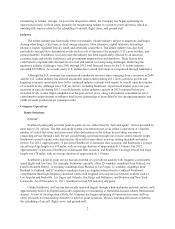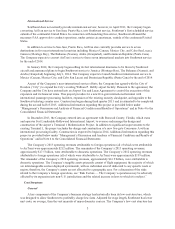Southwest Airlines 2013 Annual Report Download - page 19
Download and view the complete annual report
Please find page 19 of the 2013 Southwest Airlines annual report below. You can navigate through the pages in the report by either clicking on the pages listed below, or by using the keyword search tool below to find specific information within the annual report.• fuel planning initiatives to safely reduce loading of excess fuel;
•Evolve cabin refresh as discussed in “Operating Strategies and Initiatives — Fleet Modernization;”
• reduced aircraft engine idle speed while on the ground, which also increases engine life; and
• galley refresh with dry goods weight reduction.
The Company has also taken significant steps towards Required Navigation Performance (“RNP”)
operations which are intended to modernize the U.S. Air Traffic Control System by addressing limitations on air
transportation capacity and making more efficient use of airspace. RNP combines the capabilities of advanced
aircraft avionics, GPS (Global Positioning System) satellite navigation (instead of less precise ground-based
navigation), and new flight procedures to (i) enable aircraft to carry navigation capabilities rather than relying on
airports; (ii) improve operational capabilities by opening up many new and more direct airport approach paths to
produce more efficient flight patterns; and (iii) conserve fuel, improve safety, and reduce carbon emissions.
Southwest began conducting GPS approach procedures during the first quarter of 2010, completed RNP training
of nearly 6,000 pilots in November 2010, and commenced RNP procedures in revenue service in January 2011.
By the end of 2013, Southwest had conducted close to 14,000 RNP approaches, including over 4,000 in 2013.
Southwest must rely on RNP approaches published by the FAA, and the rate of introduction of RNP approaches
has been slower than expected, with fuel efficient RNP approaches currently available at only 36 airports. In
addition, even at airports with approved RNP approaches, the clearance required from air traffic controllers to
perform RNP approaches is sometimes not granted. Southwest continues to work with the FAA to develop more
RNP approaches and to modify air traffic control rules to support greater utilization of RNP. As a result of the
FAA’s recent lack of emphasis on continuing to implement this technology and the Company’s continued
retirement of its older Classic (737-300/500) aircraft, the Company has decided not to equip its Classic aircraft
with RNP capabilities.
Aggressive Promotion of the Company’s Points of Differentiation from its Competitors
During 2013, the Company continued to benefit from, and aggressively market, Southwest’s points of
differentiation from its competitors. For example, Southwest continues to be the only major U.S. airline that does
not impose additional fees for first and second checked bags. Through both its national and local marketing
campaigns, Southwest has continued to aggressively promote this point of differentiation from its competitors
with its “Bags Fly Free®” message. The Company believes its decision not to charge for first and second checked
bags on Southwest, as reinforced by the Company’s related marketing campaign, has driven an increase in
Southwest’s market share and a resulting net increase in revenues.
Southwest is also the only major U.S. airline that does not impose a fee on any of its fares for a Customer
change in flight plans. The Company has continued to incorporate this key point of differentiation in its
marketing campaigns. The campaigns highlight the importance to Southwest of Customer Service by showing
that Southwest understands plans can change and therefore does not charge a change fee. While a Customer may
pay a difference in airfare, the Customer will not be charged a change fee on top of any difference in airfare.
Also unlike most of its competitors, Southwest does not impose additional fees for items such as seat
selection, fuel surcharges, snacks, curb-side checkin, and telephone reservations. In addition, Southwest allows
each ticketed Customer to check one stroller and one car seat free of charge, in addition to the two free checked
bags.
The Company also continues to promote all of the many other reasons to fly Southwest such as its low
fares, network size, Customer Service, free live television offerings (discussed below under “Inflight WiFi and
Entertainment”), and its Rapid Rewards frequent flyer program.
Business Traveler Amenities
Southwest offers several products that have been designed to attract business/full fare travelers.
11
























